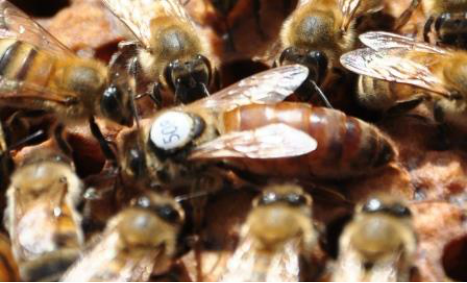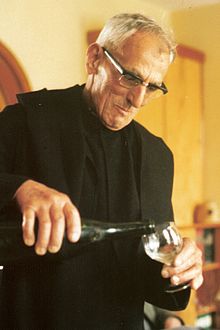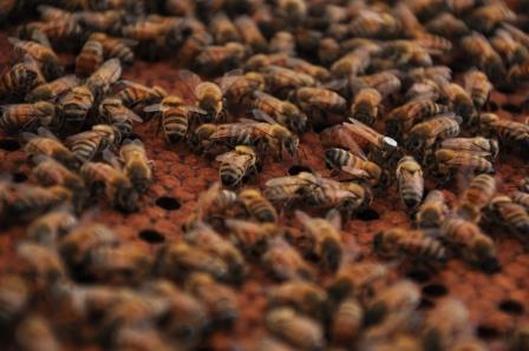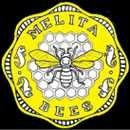Api Regine Buckfast
On Sale
On Sale
MDS - Mediterranean Dark Star (Buckfast Queen Bee)
Sold out
Buckfast Queen Bees selected in Sicily. In spring it develops quickly but without impulse to swarm. Collect a lots of pollen. Productive with strong nectariferous flows (like Orange). It bears hot, dry summers and rainy, windy winters well.
On Sale
On Sale
CDS - Continental Dark Star (Buckfast Queen Bees)
Buckfast Queen Bees selected in continental Germany. In spring it develops quickly and is perfect for early flowerings and strong nectariferous flows (like Acacia). Collect a lots of pollen. Bears good hot summers and cold winters.
On Sale
On Sale
ADS - Atlantic Dark Star (Buckfast Queen Bees)
Sold out
Buckfast Queen Bees selected in Atlantic France. Extremely sweet. In spring it develops fastly but arrives ready for harvest without impulse to swarm. Very productive on important nectariferous flows. Bears good wet and rainy winters. Due to its docility and low propensity to swarming, it's very good for urban beekeeping.
On Sale
On Sale
BDS - Boreal Dark Star (Buckfast Queen Bees)
Sold out
Buckfast Queen Bees selected in northern Germany. In spring it develops according to the rhythm of the season, and arrives ready for harvest without impulse to swarm. It bears very well long, cold winters. Accustomed to very short and intense seasons, it accumulates large amounts of Pollen.
ELGON Queen Bees (Italian/Buckfast + Monticola/Sahariensis)
Sold out
As African bees in South America developed resistance to Varroa in just 5 years, some Swedish beekeepers came up with the idea of obtaining reproductive material from a variety of African bees that are easy to handle and very similar to European bees (without the extremes defensive behavior of the variety brought to South America).
In March 1989 a group of four Swedish beekeepers went to Mount Elgon, Kenya, and collected drone sperm in capillary tubes and small larvae and eggs in small pieces of honeycomb. The purpose of using this breeding material was to increase the vitality and genetic variation of European bees with a "high potency natural resource". The bee breed was the Apis Mellifera Monticola, a dark and robust bee with a relatively good character and therefore easy to handle. Also in 1989 sperm and eggs from crosses between Buckfast bee and Apis Mellifera Sahariensis were brought to Sweden from Holland with the aim of avoiding inbreeding. It was easy to get good pairings with both Buckfast bees and Italian bees and the resulting bee is not a Buckfast bee, strictly speaking, but very similar, with a marked defensive behavior against varroa.
VSH Queen Bees (Buckfast)
Sold out
Untreated honey bees in tropical environments have been observed to develop certain levels of resistance to varroa. The strong selective pressure (no treatment by beekeepers, therefore a lot of Varroa) combined with a favorable climate for bees, allows a certain percentage of colonies to survive long enough to guarantee the creation of offspring (swarms, new colonies). These colonies have inherited one or more traits that help them keep the Varroa infestation under control.
Also in the institutes, colonies have been selected that have favorable traits and can better control the number of Varroa in the hive. The best results so far are achieved by selecting honey bees with Varroa Sensitive Hygiene (VSH) behavior: these bees can detect Varroa in the brood and remove the brood with Varroa so that Varroa cannot reproduce and multiply.
PRIMORSKY Queen Bees (Apis Mellifera Sossimai x Buckfast)
Sold out
In the Primorsky region, on the eastern coast of Siberia overlooking the Pacific Ocean (capital: Vladivostok), the honey bee was not present in nature, but the Cerana, the natural host of the Varroa mite. Towards the end of the 19th century, the settlers came from the European part of the Russian Empire, particularly from Ukraine. These brought with them colonies of bees, which presumably soon came into contact with Varroa mites from the nearby colonies of Cerana. However, varroa was only detected in this region in 1952. It can therefore be assumed that long-term natural selection has occurred here for resistance to varroa, as during most of this period no treatments were carried out against varroa. varroa.
Hygienic behavior can have a positive impact on a colony's ability to control the Varroa population. The USDA-ARS Bee Lab in Baton Rouge compared Russian bee colonies to other domestic lines and found that Primorski exhibited hygienic behavior at a much higher level (69% vs 37%). It was also observed that in the anti-varroa funds, colonies of Russian bees showed numerous Varroa mites with missing appendages and bite marks.

L'ape Buckfast è frutto dell'incrocio diverse sottospecie di api mellifere. Sviluppata da "Padre Adam" (nato Karl Kehrle il 3 agosto 1898 in Germania), era responsabile dell'apicoltura presso l'abbazia di Buckfast, dove ancora oggi si allevano api. La maggior parte del lavoro di selezione in Europa viene svolto da allevatori appartenenti all'associazione Gemeinschaft der Europäischen Buckfastimker. Questa organizzazione mantiene un albero genealogico per le api Buckfast, originato dagli anni del fratello Adam.
Origine
Nel 1916 nell'abbazia di Buckfast solo 16 colonie sopravvissero: erano tutte di pura "Ligustica" o ibridi tra l'ape Mellifera Inglese e la Ligustica. Alla luce di questo Padre Adam iniziò ad incrociare sistematicamente l'ape italiana (Ligustida) con l'ape Mellifera Mellifera inglese, scoprendo con sorpresa che l'ibrido che ne risultava non solo era resistente all'acariosi, ma aveva capacità produttive nettamente superiori a quelle delle api ligustiche o mellifere prese singolarmente.
Patrimonio Genetico
Storia
 Brother Adam
Brother Adam
Ogni nuovo ceppo o razza di api importato venne incrociato con l'ape Buckfast iniziale. Nella maggior parte dei casi, le nuove qualità desiderate vennero trasmesse alla nuova generazione e la nuova combinazione venne poi resa stabile con ulteriori lavori di allevamento. Ogni incrocio con una nuova razza impiegava circa 10 anni prima che i geni desiderati venissero fissati nel ceppo. Per oltre 70 anni, Padre Adam ha lavorato per ottenere un'ape vigorosa, sana e feconda che battezzò l'ape Buckfast.
L'ape Buckfast è sempre più popolare tra gli apicoltori ed è disponibile presso gli allevatori di api in Germania, Irlanda, Regno Unito, Francia e altri. La maggior parte delle qualità dell'ape Buckfast sono molto favorevoli. Sono estremamente docili e altamente produttivi. Padre Adam, nel suo libro "Apicoltura all'Abbazzia di Buckfast", scrive che nel 1920 ottennero "una media di non meno di 192 libbre di surplus per colonia e rese individuali superiori a 3 cwt [circa 336 libbre]. "Nel 1986 BBC- documentario affiliato, "Il Monaco e le Api", si dice che più di 400 libbre di miele siano state prodotte da una singola colonia Buckfast. Secondo Padre Adam, "La resa media annua di miele negli ultimi trent'anni è stata di 30 kg (66 libbre) per colonia. Abbiamo quindi un equilibrio favorevole rispetto alla produzione media in America o in Europa".
Le regine Buckfast sono state importate anche negli Stati Uniti (uova, sperma e regine adulte attraverso il Canada).
Programma di allevamento Buckfast

Caratteri Primari
Le qualità primarie sono quelle qualità essenziali massimizzare la produzione di miele:
- Fecondità - mantenimento di almeno 9 telai di covata Langstroth (6 Dadant) da maggio - luglio
- Ardore nel bottinare - una capacità illimitata per il lavoro di foraggiamento; la stretta consanguineità per intensificare questa qualità può essere controproducente.
- Resistenza alle malattie
- Scarsa propensione alla sciamatura
Caratteri secondari
- Longevità
- Potenza di volo
- Senso dell'olfatto
- Comportamento igienico
- Robustezza e capacità di svernare
- Sviluppo primaverile
- Mantenimento delle scorte
- Istinto di autoapprovvigionamento
- Disposizione del miele nei favi
- Produzione della cera e costruzione dei favi
- Raccolta di polline
- Lunghezza della ligula
Caratteri terziari
- Docilità
- Comportamento calmo
- Riluttanza a propolizzare
- Riluttanza a costruire ponti di cera
- Pulizia
- Opercolatura del miele
- Senso di orientamento
Caratteristiche
Punti di forza
- Ottime produttrici di miele
- Regine molto prolifiche
- Sverna bene
- Frugale - bassa quantità di covata durante l'autunno (utilizza meno riserve di miele durante l'inverno)*
- Immagazzina nel nido le giuste scorte per l'inverno
- Riduce la deposizione durante i peridi di carestia*
- L'allevamento della covata cessa durante il tardo autunno*
- Estremamente docile, con una scarsa propensione a pungere
- Scarsa attitudine alla sciamatura
- Elevata tolleranza agli acari della trachea
- Bassa incidenza di tignole e tarme della cera grazie al buon istinto di pulizia
- Comportamento igienico
- Crescita rapida delle colonie
- Scarsa propensione a propolizzare
- Sopporta bene le primavere umide e fredde
*N.B.: alcune selezioni hanno un comportamento opposto
Difetti
- Bassa quantità di covata durante l'inverno
- Scarso raccolto di miele e polline in condizioni meteorologiche primaverili irregolari
- Possibili comportamenti difensivi alla seconda generazione delle figlie naturali (può derivare da geni africanizzati introdotti)
On Sale
On Sale
BDS - Boreal Dark Star (Buckfast Queen Bees)
Sold out
Buckfast Queen Bees selected in northern Germany. In spring it develops according to the rhythm of the season, and arrives ready for harvest without impulse to swarm. It bears very well long, cold winters. Accustomed to very short and intense seasons, it accumulates large amounts of Pollen.
On Sale
On Sale
ADS - Atlantic Dark Star (Buckfast Queen Bees)
Sold out
Buckfast Queen Bees selected in Atlantic France. Extremely sweet. In spring it develops fastly but arrives ready for harvest without impulse to swarm. Very productive on important nectariferous flows. Bears good wet and rainy winters. Due to its docility and low propensity to swarming, it's very good for urban beekeeping.
On Sale
On Sale
CDS - Continental Dark Star (Buckfast Queen Bees)
Buckfast Queen Bees selected in continental Germany. In spring it develops quickly and is perfect for early flowerings and strong nectariferous flows (like Acacia). Collect a lots of pollen. Bears good hot summers and cold winters.
On Sale
On Sale
MDS - Mediterranean Dark Star (Buckfast Queen Bee)
Sold out
Buckfast Queen Bees selected in Sicily. In spring it develops quickly but without impulse to swarm. Collect a lots of pollen. Productive with strong nectariferous flows (like Orange). It bears hot, dry summers and rainy, windy winters well.
ELGON Queen Bees (Italian/Buckfast + Monticola/Sahariensis)
Sold out
As African bees in South America developed resistance to Varroa in just 5 years, some Swedish beekeepers came up with the idea of obtaining reproductive material from a variety of African bees that are easy to handle and very similar to European bees (without the extremes defensive behavior of the variety brought to South America).
In March 1989 a group of four Swedish beekeepers went to Mount Elgon, Kenya, and collected drone sperm in capillary tubes and small larvae and eggs in small pieces of honeycomb. The purpose of using this breeding material was to increase the vitality and genetic variation of European bees with a "high potency natural resource". The bee breed was the Apis Mellifera Monticola, a dark and robust bee with a relatively good character and therefore easy to handle. Also in 1989 sperm and eggs from crosses between Buckfast bee and Apis Mellifera Sahariensis were brought to Sweden from Holland with the aim of avoiding inbreeding. It was easy to get good pairings with both Buckfast bees and Italian bees and the resulting bee is not a Buckfast bee, strictly speaking, but very similar, with a marked defensive behavior against varroa.
VSH Queen Bees (Buckfast)
Sold out
Untreated honey bees in tropical environments have been observed to develop certain levels of resistance to varroa. The strong selective pressure (no treatment by beekeepers, therefore a lot of Varroa) combined with a favorable climate for bees, allows a certain percentage of colonies to survive long enough to guarantee the creation of offspring (swarms, new colonies). These colonies have inherited one or more traits that help them keep the Varroa infestation under control.
Also in the institutes, colonies have been selected that have favorable traits and can better control the number of Varroa in the hive. The best results so far are achieved by selecting honey bees with Varroa Sensitive Hygiene (VSH) behavior: these bees can detect Varroa in the brood and remove the brood with Varroa so that Varroa cannot reproduce and multiply.
PRIMORSKY Queen Bees (Apis Mellifera Sossimai x Buckfast)
Sold out
In the Primorsky region, on the eastern coast of Siberia overlooking the Pacific Ocean (capital: Vladivostok), the honey bee was not present in nature, but the Cerana, the natural host of the Varroa mite. Towards the end of the 19th century, the settlers came from the European part of the Russian Empire, particularly from Ukraine. These brought with them colonies of bees, which presumably soon came into contact with Varroa mites from the nearby colonies of Cerana. However, varroa was only detected in this region in 1952. It can therefore be assumed that long-term natural selection has occurred here for resistance to varroa, as during most of this period no treatments were carried out against varroa. varroa.
Hygienic behavior can have a positive impact on a colony's ability to control the Varroa population. The USDA-ARS Bee Lab in Baton Rouge compared Russian bee colonies to other domestic lines and found that Primorski exhibited hygienic behavior at a much higher level (69% vs 37%). It was also observed that in the anti-varroa funds, colonies of Russian bees showed numerous Varroa mites with missing appendages and bite marks.
